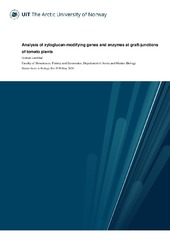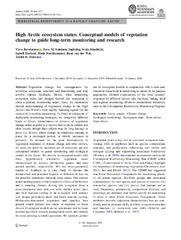Institutt for arktisk og marin biologi: Nye registreringer
Viser treff 1061-1080 av 2084
-
Analysis of xyloglucan-modifying genes and enzymes at graft-junctions of tomato plants
(Master thesis; Mastergradsoppgave, 2020-05-16)Grafting is a widely used technique for propagation of plants in both agriculture and horticulture worldwide and involves combining two or more plants into one chimeric plant, ultimately with a shared vascular system. Benefits of grafting such as pathogen resistance, increase in fruit yield and abiotic stress tolerance have long been known, but the biological mechanisms of how plants graft are still ... -
Addressing the aquatic vertebrate community of Vågsfjorden 2019 with the use of Environmental DNA
(Master thesis; Mastergradsoppgave, 2020-05-15)In order to estimate biodiversity or do species counts, detramental techniques such as trawling or longlining have been used. Lately techniques used to monitor, such as baited remote underwater video systems and environmental DNA have been tested as possible methods to investigate species richness and abundance, the latter which will be used in this thesis. Using eDNA methodology, a northern ... -
Genetic population structure of the northern shrimp (Pandalus borealis) along the Norwegian coast
(Master thesis; Mastergradsoppgave, 2020-05-15)The coastal shrimp (Pandalus borealis) represent an important income for a small-scale fishery. The more economical important fishery of shrimp is located offshore. There is sparse information and literature regarding the coastal shrimp, and it is a lot we do not know about the species that inhabits our coast and fjords. Genetic research will provide more information on the species in these areas. ... -
High Arctic ecosystem states: Conceptual models of vegetation change to guide long-term monitoring and research
(Journal article; Tidsskriftartikkel; Peer reviewed, 2020-01-18)Vegetation change has consequences for terrestrial ecosystem structure and functioning and may involve climate feedbacks. Hence, when monitoring ecosystem states and changes thereof, the vegetation is often a primary monitoring target. Here, we summarize current understanding of vegetation change in the High Arctic—the World’s most rapidly warming region—in the context of ecosystem monitoring. To ... -
Arctic Observations Identify Phytoplankton Community Composition as Driver of Carbon Flux Attenuation
(Journal article; Tidsskriftartikkel; Peer reviewed, 2020-06-24)The attenuation coefficient <i>b</i> is one of the most common ways to describe how strong the carbon flux is attenuated throughout the water column. Therefore, <i>b</i> is an essential input variable in many carbon flux and climate models. Marsay et al. (2015, <a href=https://doi.org/10.1073/pnas.1415311112>https://doi.org/10.1073/pnas.1415311112</a>) proposed that the median surface water temperature ... -
Interactions between winter and summer herbivory affect spatial and temporal plant nutrient dynamics in tundra grassland communities
(Journal article; Tidsskriftartikkel; Peer reviewed, 2020-04-27)In the long‐term, herbivores can alter nutrient dynamics in terrestrial ecosystems by changing the functional composition of plant communities. Here, we ask to what extent herbivores can affect plant‐community nutrient dynamics in the short‐term. We provide theoretical expectations for immediate effects of herbivores on tundra‐grassland plant‐community nutrient levels throughout a single growing ... -
A Widely Distributed Thraustochytrid Parasite of Diatoms Isolated from the Arctic Represents a gen. and sp. nov.
(Journal article; Tidsskriftartikkel; Peer reviewed, 2020-04-06)A unicellular, heterotrophic, eukaryotic parasite was isolated from nearshore Arctic marine sediment in association with the diatom <i>Pleurosigma</i> sp. The parasite possessed ectoplasmic threads that could penetrate diatom frustules. Healthy and reproducing <i>Pleurosigma</i> cultures would begin to collapse within a week following the introduction of this parasite. The parasite (2–10 μm diameter) ... -
Gammaherpesvirus in Cervid Species from Norway: Characterization of a New Virus in Wild and Semi-Domesticated Eurasian Tundra Reindeer (Rangifer tarandus tarandus)
(Journal article; Tidsskriftartikkel; Peer reviewed, 2020)Gammaherpesvirus infections have been described in cervids worldwide, mainly the genera <i>Macavirus</i> or <i>Rhadinovirus</i>. However, little is known about the gammaherpesviruses species infecting cervids in Norway and Fennoscandia. Blood samples from semi-domesticated (<i>n</i> = 39) and wild (<i>n</i> = 35) Eurasian tundra reindeer (<i>Rangifer tarandus tarandus</i>), moose (<i>Alces alces</i>, ... -
One leaf for all: Chemical traits of single leaves measured at the leaf surface using near-infrared reflectance spectroscopy
(Journal article; Tidsskriftartikkel; Peer reviewed, 2020-06-10)1. The leaf is an essential unit for measures of plant ecological traits. Yet, measures of plant chemical traits are often achieved by merging several leaves, masking potential foliar variation within and among plant individuals. This is also the case with cost‐effective measures derived using near‐infrared reflectance spectroscopy (NIRS). The calibration models developed for converting NIRS spectral ... -
Bearded seal vocalisations across seasons and habitat types in Svalbard (Norway)
(Master thesis; Mastergradsoppgave, 2019-08-15)Male bearded seals use vocal displays to attract females and compete with other males during the mating period, making it possible to monitor breeding populations using passive acoustic monitoring (PAM). This study analysed year-round acoustic data from underwater recorders at three sites with different environmental conditions in Svalbard (Norway). Male bearded seals vocalised for an extended ... -
An interannual study of foraging behaviour in sympatrically breeding macaroni Eudyptes chrysolophus and chinstrap penguins Pygoscelis antarcticus at Bouvetøya
(Master thesis; Mastergradsoppgave, 2019-08-15)Species are likely to segregate their ecological niches to minimize competition for resources, but for centrally foraging predators that breed on sub-Antarctic islands in the Southern Ocean the possibility of niche segregation may be minimal. This study is the first to examine the spatial and trophic aspects of the foraging niche of sympatrically breeding macaroni and chinstrap penguins at the ... -
Size‐and stage‐dependence in cause‐specific mortality of migratory brown trout
(Journal article; Tidsskriftartikkel; Peer reviewed, 2020-05-29)<ol> <li>Evidence‐based management of natural populations under strong human influence frequently requires not only estimates of survival but also knowledge about how much mortality is due to anthropogenic vs. natural causes. This is the case particularly when individuals vary in their vulnerability to different causes of mortality due to traits, life history stages, or locations.</li> <li>Here, ... -
Gyrodactylus triglopsi n. sp. (Monogenea: Gyrodactylidae) from the Gills of Triglops nybelini Jensen, 1944 (Teleostei: Cottidae) in the Barents Sea
(Journal article; Tidsskriftartikkel; Peer reviewed, 2020-04-28)<i>Introduction</i> - Monogeneans of the genus <i>Gyrodactylus</i> were found on the gills of specimens of the bigeye sculpin <i>Triglops nybelini</i> Jensen, 1944 caught by trawl in the Barents Sea in January–February 2016.<p> <p><i>Methods</i> - Morphological preparations of the parasites were examined and photographed under a microscope at magnifcations of×100–1000 and morphometric analyses ... -
Denning phenology of polar bears (Ursus maritimus) in the Barents Sea population
(Master thesis; Mastergradsoppgave, 2019-07-31)Timing reproductive effort to match food availability is important due to high energetic costs of reproduction. Female polar bears need sufficient time in the den to nurse cubs until they are big enough to withstand the Arctic environment, however females’ emergence from the den needs to be synchronized with ringed seal pupping peak, which is a crucial energy source for polar bears. The phenology ... -
Predation mortality from ambush and cruising predators on newly-settled 0-group gadoids
(Journal article; Tidsskriftartikkel; Peer reviewed, 2020-05-15)We investigated predation from an ambush predator (shorthorn sculpin) and two cruising predators (Atlantic cod and saithe) on bottom-settled 0-group cod and saithe juveniles in a fjord in northern Norway. Stomach contents of potential fish predators caught by gill net in shallow waters (depth of 3–10 m) during September in 2013–2015 were analysed. The frequency of occurrence (FO) of 0-group gadoid ... -
The Demographic buffering hypothesis: Evidence and challenges
(Journal article; Tidsskriftartikkel; Peer reviewed, 2020-06)In (st)age-structured populations, the long-run population growth rate is negatively affected by temporal variation in vital rates. In most cases, natural selection should minimize temporal variation in the vital rates to which the long-run population growth is most sensitive, resulting in demographic buffering. By reviewing empirical studies on demographic buffering in wild populations, we found ... -
Simulated trawling: Exhaustive swimming followed by extreme crowding as contributing reasons to variable fillet quality in trawl-caught Atlantic cod (Gadus morhua)
(Journal article; Tidsskriftartikkel; Peer reviewed, 2020-06-18)Trawl-caught Atlantic cod (Gadus morhua) often yield highly variable fillet quality that may be related to capture stress. To investigate mechanisms involved in causing variable quality, commercial-sized (3.5±0.9 kg) Atlantic cod were swum to exhaustion in a large swim tunnel and subsequently exposed to extreme crowding (736±50 kg m<sup>-3</sup>) for 0, 1 or 3 hours in an experimental cod-end. The ... -
Car tire crumb rubber: Does leaching produce a toxic chemical cocktail in coastal marine systems?
(Journal article; Tidsskriftartikkel; Peer reviewed, 2020-07-23)Crumb rubber granulate (CRG) produced from end of life tires (ELTs) is commonly applied to synthetic turf pitches (STPs), playgrounds, safety surfaces and walkways. In addition to fillers, stabilizers, cross-linking agents and secondary components (e.g., pigments, oils, resins), ELTs contain a range of other organic compound and heavy metal additives. While previous environmental impact studies on ... -
Kvalitetskrav for vann til jordvanning. Uttalelse fra Faggruppen for hygiene og smittestoffer i Vitenskapskomiteen for mattrygghet
(Research report; Forskningsrapport, 2014-05-07)Ved vanning av spiselige jordbruksvekster på friland i Norge brukes det overflatevann, grunnvann eller vann fra gravd brønn. Vannet kan være offentlig eller privat. Mikroorganismer og uønskede kjemiske stoffer i slikt vann kan forårsake sykdom, dersom dette benyttes til vanning av vegetabiler. For sykdomsfremkallende mikroorganismer gjelder dette spesielt ved vanning av vegetabiler som skal spises ... -
Synergism between cruising cod and ambush sculpin predators on 0-group gadoids is modified by daylight cycle and presence of aggressive wolffish
(Journal article; Tidsskriftartikkel; Peer reviewed, 2020-03-06)Shorthorn sculpin (<i>Myoxocephalus scorpius</i>) and large cod (300–400 g body weight) are important predators on newly settled 0-group cod (<i>Gadus morhua</i>) and saithe (<i>Pollachius virens</i>) in Porsangerfjorden in northern Norway. The Atlantic wolffish (<i>Anarhichas lupus</i>) used to be abundant but is now very rare in the fjord. Video recorded experiments showed that interactions between ...


 English
English norsk
norsk


















